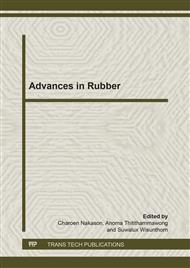p.178
p.182
p.186
p.190
p.194
p.198
p.201
p.205
p.209
Effect of Rubber Clone on Fatty Acid Composition and Properties of Air Dried Sheet
Abstract:
Properties of air dried sheet (ADS) made from four different clones of Hevea brasiliensis (BPM24, RRIM600, PR255 and PB235) were investigated. BPM24, RRIM600 and PR255 rubbers show a bimodal molar mass distribution (MMD) while PB235 rubber has quasi-unimodal molar mass distribution. It was found that ADS from rubber clone with bimodal MMD (BPM24, RRIM600 and PR255) displayed lower original plasticity (P0) but higher plasticity retention index (PRI). Those rubber samples with bimodal MMD show higher accelerated storage hardening test (ASHT) values than ADS from PB235. Within bimodal rubbers, ADS from PR255 displayed lower PRI and P than the 2 other clones, i.e. RRIM600 and BPM24. ADS made from BPM24 and RRIM600 presented similar fatty acid composition with 3 major fatty acids namely linoleic acid (C18:2), stearic acid (C18:0) and oleic acid (C18:1). In contrast, major fatty acids of ADS made from PR255 were linoleic acid (C18:2) and furan fatty acid. Moreover, ADS from PB235 showed the highest amount of furan fatty acid which confirmed the results of Liengprayoon et al. [1]. Relationship between mesostructure, fatty acids composition and ADS properties are discussed.
Info:
Periodical:
Pages:
194-197
Citation:
Online since:
November 2013
Keywords:
Price:
Сopyright:
© 2014 Trans Tech Publications Ltd. All Rights Reserved
Share:
Citation:


